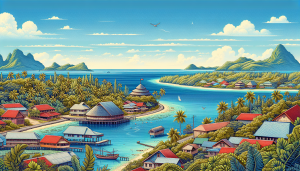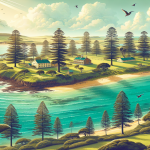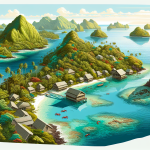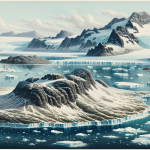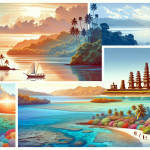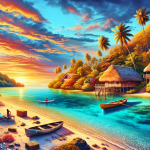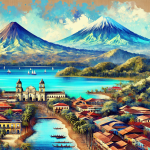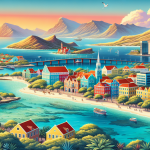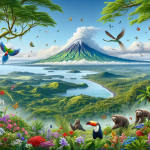Discover the Hidden Gem of the Pacific: Nauru
Hidden away in the vast expanse of the Pacific Ocean lies a tiny island nation few have heard of, yet it holds a treasure trove of experiences for the intrepid traveler. **Nauru**, the world’s third smallest country by land area, is an off-the-beaten-path destination that promises unique adventures and a glimpse into a distinctive culture. Despite its small size, Nauru offers a rich history, stunning landscapes, and an intimate connection with the ocean that surrounds it. As you step into this **micronation**, you’re not just visiting a place, but immersing yourself in a story of resilience, beauty, and simplicity that is rarely found in today’s bustling travel destinations. This article will delve deep into the wonders of Nauru, uncovering its history, exploring its natural beauty, and guiding you through the must-see sites and activities that make Nauru a hidden gem worth discovering.
A Brief History of Nauru
Nauru’s history is as complex and fascinating as the island itself. Originally settled by **Micronesian and Polynesian people** at least 3,000 years ago, Nauru’s rich culture stems from its diverse influences. The island was first sighted by European explorers in 1798, when British captain John Fearn dubbed it “Pleasant Island” due to its lush, welcoming appearance. Fast forward to the late 19th and early 20th centuries, Nauru became a point of interest for its phosphate resources, leading to a period of colonization by Germany, Australia, New Zealand, and the United Kingdom.
**Phosphate mining** dominated Nauru’s economy throughout the 20th century, bringing both prosperity and challenges. The island gained independence in 1968, but the depletion of phosphate reserves has since pushed Nauru to seek sustainable ways to support its economy. Today, Nauru is a testament to resilience, adapting to new economic opportunities while preserving its cultural heritage.
Exploring Nauru’s Natural Beauty
Despite its small size, Nauru boasts an array of natural wonders that captivate the senses. The island is encircled by a pristine coral reef, making it a paradise for snorkeling and diving enthusiasts. **Anibare Bay**, with its white sandy beaches and crystal-clear waters, is a perfect spot for a relaxing day by the sea. The bay is also known for its excellent fishing, with locals often seen casting their nets in the early morning light.
For those interested in exploring the island’s interior, the **Buada Lagoon** offers a serene escape. This freshwater lagoon, surrounded by lush vegetation, is a rare sight in the Pacific and provides a peaceful retreat for visitors looking to connect with nature. Another must-visit location is **Command Ridge**, the highest point on the island, where you can find remnants of World War II relics, including Japanese gun emplacements and bunkers. The panoramic views from Command Ridge are breathtaking, offering a unique perspective of the island’s landscape.
Cultural Experiences in Nauru
Nauru’s culture is a tapestry of traditions, influenced by its Micronesian and Polynesian roots. The island’s inhabitants, known as **Nauruans**, are deeply connected to their customs and way of life. One of the best ways to experience Nauru’s culture is through its **traditional music and dance**. The rhythmic beats of the traditional “**Ekatak**” dance, performed during special ceremonies and celebrations, are a vibrant expression of Nauruan heritage.
Visitors can also explore the island’s history at the **Nauru Museum**, which houses a collection of artifacts, photographs, and exhibits that chronicle the island’s past. The museum provides valuable insights into Nauru’s journey from its early settlement to its modern-day challenges and triumphs. Additionally, engaging with the local community is a rewarding experience that offers a deeper understanding of Nauruan life. The island’s residents are known for their hospitality and are always eager to share their stories and traditions with visitors.
Adventure and Activities in Nauru
For adventure seekers, Nauru offers a variety of activities that cater to different interests. **Scuba diving** is a popular activity, with several dive sites around the island that reveal the vibrant underwater world of coral reefs and marine life. The **Central Plateau**, once the heart of phosphate mining, has been transformed into a rugged landscape perfect for hiking and exploring. The plateau’s unique terrain provides a striking contrast to the island’s coastal beauty, making it a fascinating area to explore.
Another exciting activity is **bird watching**. Nauru is home to several species of seabirds and land birds, making it a haven for bird enthusiasts. The island’s diverse habitats, from coastal areas to inland forests, provide ample opportunities to spot these feathered residents. For those interested in sports, **Australian rules football** and weightlifting are popular among Nauruans, and visitors are often welcome to join in or watch local matches and competitions.
Sustainable Tourism in Nauru
As Nauru continues to evolve, sustainable tourism is becoming an important focus. The island’s government and local organizations are working together to promote eco-friendly practices that protect Nauru’s natural environment and cultural heritage. Travelers to Nauru are encouraged to respect the island’s ecosystems and support local businesses, ensuring that tourism benefits the community and preserves the island’s beauty for future generations.
One of the key initiatives in sustainable tourism is the promotion of **community-based tourism**, where visitors can engage with local families and participate in traditional activities. This approach not only provides a more authentic experience for travelers but also supports the local economy and fosters cultural exchange. Additionally, efforts are being made to rehabilitate areas affected by phosphate mining, transforming them into green spaces and nature reserves.
Practical Information for Travelers
When planning a trip to Nauru, there are a few practical considerations to keep in mind. **Visa requirements** vary depending on your nationality, so it’s important to check the latest information from Nauru’s immigration authorities. The island’s main point of entry is **Nauru International Airport**, which is serviced by Nauru Airlines with flights from Australia, Fiji, and other Pacific destinations.
Accommodation options on the island are limited, but there are a few hotels and guesthouses that offer comfortable stays. It’s advisable to book your accommodation in advance, especially during peak travel seasons. The island’s small size makes getting around relatively easy, with taxis and rental cars available for transportation. Bicycles are also a popular and eco-friendly way to explore the island at your own pace.
While Nauru’s remote location means that some amenities may be limited, the island’s charm lies in its simplicity and natural beauty. Travelers are encouraged to come with an open mind and a spirit of adventure, ready to embrace the unique experiences that Nauru has to offer.
Conclusion
Nauru may be one of the world’s smallest countries, but it offers a wealth of experiences that are sure to leave a lasting impression. From its rich history and vibrant culture to its stunning natural landscapes and adventurous activities, Nauru is a destination that beckons to be explored. By supporting sustainable tourism and engaging with the local community, travelers can contribute to the preservation of this hidden gem for future generations. So, pack your bags and set off on an unforgettable journey to discover the wonders of Nauru.
For more information on planning your trip to Nauru, visit the official [Nauru Tourism website](https://www.discovernauru.com).
